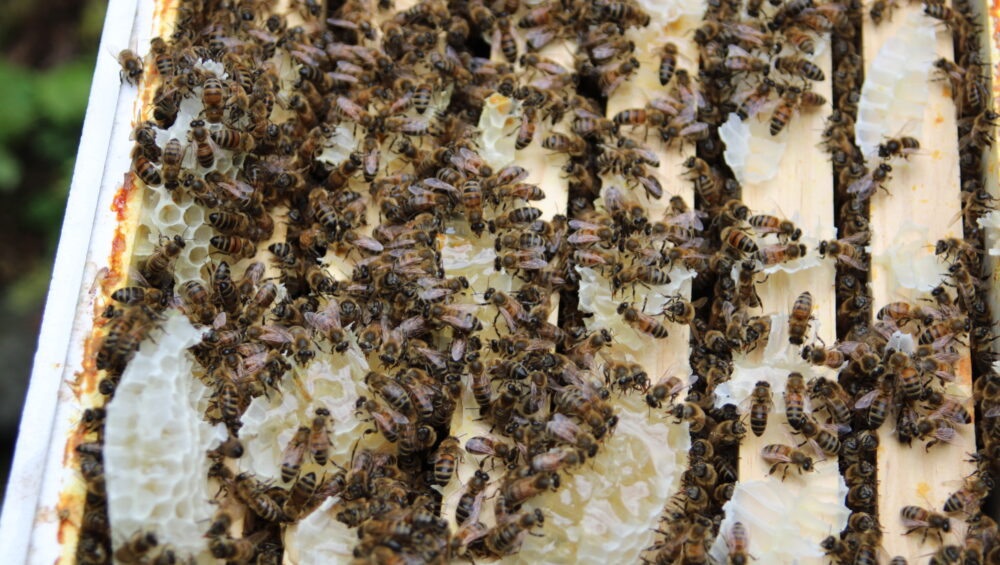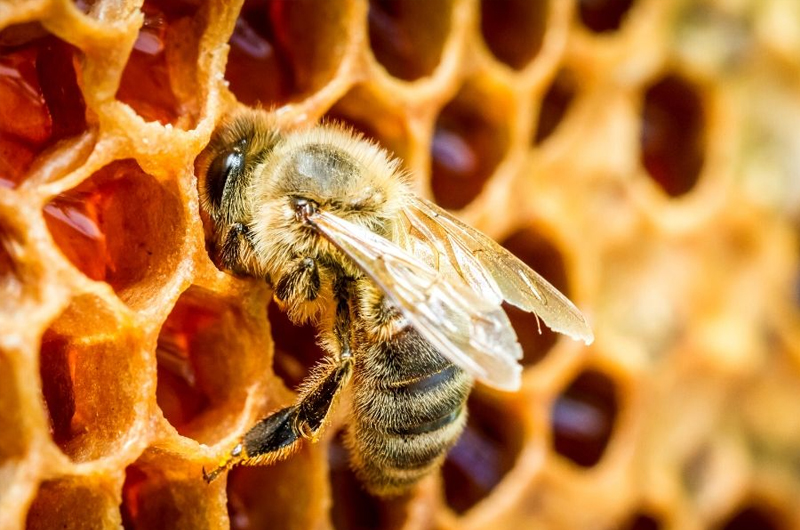Small Scale Queen Rearing
By Rudy Repka, Sidcup, Kent BKA.
Queen rearing is easy, interesting and a rewarding beekeeping activity. Unlike queen breeding, it does not require any particular knowledge of genetics. There are several methods for queen rearing, each with some modifications, but they all pursue the same principle: to follow bees’ instincts and with a measure of control create the conditions, which will encourage your selected colony to favour its reproduction.
Timing for queen rearing
It is an advantage to use favourable climatic conditions in the late spring, which naturally stimulate this colony reproduction. In the UK, the best time to start queen rearing is from mid May to mid June. With luck, you may catch the spring nectar flow, which will help to feed your developing queen larvae. A month later your newly mated queens will start laying with the help of the early summer flow, establish their little colonies thus allowing you to assess their qualities soon after. If you do it a little earlier or much later, it can be something of a challenge.
Rearing one’s replacement queens allows the beekeeper to have a real influence on the selection for the desired over undesirable colony qualities. This basis of good bee management and enables the beekeeper to replace at will the queens which are heading his or her colonies. With small adjustments, the technique is suitable for rearing any number of mated queens. The limiting factor is the number of support colonies you wish to maintain. One large colony, dedicated to the queen rearing, can on its own raise a batch of perhaps twelve to fifteen mated queens. Such a colony will easily nurture forty or more grafted larvae, but you will need the equipment and bees for populating the mating nucleus hives. For scaling up your queen rearing to raise many more queens, you may need several large prosperous support colonies, providing an adequate supply of fresh frames with emerging brood and young bees to your main queen rearing colony, so that it can nurture further batches of fresh grafts. These can be inserted every five days. The previous batch of sealed queen cells can be moved on to other incubator colonies. If you do not wish to run incubator colonies, you can insert a fresh batch of grafted cells into your queen rearing colony every ten days.
Drone selection
Although I am not dealing with queen breeding here, it is still worthwhile to consider the drones your queens will mate with. They will mate with any fit drones in the drone congregation area, but you can, if you choose, add to this mix a proportion of your own drones possessing the qualities you want. If you wish, try rearing your own drones and you will notice a clear influence on the quality of your queens; give your drones a head start, about a month before you commence with queen rearing. Drones take longer to develop at the larval stage, and even longer to reach their sexual maturity after emerging so you need to consider starting this part of your queen rearing process in late March, weather permitting. Surprisingly, rearing of your sought-after and fit drones, with viable sperm, can be more difficult than anticipated. Select a suitable colony, whose bees have the required qualities, and insert a frame or two, fitted with the drone base foundation. Feed this colony well with both syrup and pollen, or with pollen substitute. Once drawn out and laid up with eggs, the frames can be transferred to other foster colonies to raise the drones. The colonies, which are raising the drones intended to mate with your virgins should not be subjected to any varroa treatments based on pyrethroids, organophosphates, or thymol. These acaricides have detrimental effects on the sperm viability and on the general fitness of drones.
Larval transfer techniques
There is a variety of larval transfer methods that can be used. It is not strictly essential to learn the simple skill of larval transfer, or ‘grafting ‘using a grafting tool, but the technique is very easy to learn, so it is well worth adopting. Queen rearing students, who have never done this before, usually achieve on their first attempt 60%-75% graft acceptance. If grafting is not for you, perhaps because you may have poor eyesight, for around £70 you can buy a kit from thebe equipment suppliers, which will enable you to do larval transfer without the need for any skillet all. The main drawbacks of this, apparently easier method, is the need to find and entrap the queen in the cage supplied with the kit, in your breeding colony. Bees resent having their queen separated from her brood and once freed from her cage, they sometimes proceed to supersede her soon after. A sad loss if her progeny has excellent qualities.
2The life cycle of the European races of an Apis mellifera queen:
Crucial timings to know when queen rearing
Stage Time
Egg 3 days
Larva feeding 5 days or slightly less
Metamorphosis (pupa) 7 days or so
Emerging 16th day or so, after egg has been laid. This can be slightly earlier.
1st orientation flight 18th day or later
Earliest mating flight 21st day or later
More usual mating flights 23rd –28th day, or on day 7 –12 after emerging
Mating window closes 32nd day, or about 16 days after emerging
Starts laying about 2 –4 days after mating
The life cycle of honeybee queens
A few of the timings are important when rearing queens, so let us consider some basic facts of the life cycle of the European races of the Apis mellifera queen. All are close approximations; the actual time can vary slightly due to race, amount of food, climate and temperature among other reasons. We usually recognize four stages of queen rearing:
1. Graft acceptance or start up
2. Cell building
3. Incubation and emergence
4. Mating
As amateurs, raising only a few queens, we usually compress these four stages into just two: Acceptance of the graft, cell building, and the first three quarters of the incubation period is the first stage. The last one quarter of incubation period, emergence and mating is the second stage. This second stage usually takes place in different and often quite small mating colonies.
A more advanced beekeeper may prefer three stages. Graft acceptance in the first, usually crowded, but small, queen less colony, is the first stage. Cell building plus three quarters of the incubation period, often in a different prosperous, queen right colony, is the second stage, and the last one quarter incubation, plus emergence and mating in nucleus colonies is the last stage. However, most professional breeders adhere to four separate stages, so let us consider each stage in little more detail.
Stage 1: Graft acceptance, start up
The start up colony needs to be suitably conditioned and prepared before it will start building queen cells. Bees will start building queen cells under one of three impulses; swarming, emergency, and supersedure.
Swarming
If we do not wish to propagate the swarming tendency, we should reject the swarming impulse for raising queen cells. However, the conditions in the colony, which is making preparation to swarm, are perfect for raising queen cells. Removing their queen and destroying all existing queen cells, will persuade bees to raise many queen cells from our donated material. You can use a swarmy colony but it is essential to destroy all queen cells which the bees will have started from their own larvae about a week after insertion of your grafts.
Emergency
Very soon after losing their queen, whether by accident or by design; bees are willing to start building queen cells. The first larvae they choose in such an emergency can be too old. The subsequent ones will be larvae of the right age. Rendering the whole colony queen less will cause a considerable set-back for the colony. It is better to make-up a five or six frames nucleus, ideally with no other very young brood, although very crowded with bees from your out-apiary. If you insert your frame with grafted cells into this fairly small queen less colony, you can get a large number of queen cells started. These can be transferred the following day and finished in the ‘finishing colony’, in the top brood box of a Demareed, queen right colony as described in the next paragraph.
Supersedure
Bees, which naturally supersede, are desirable. This is not under our control although we can simulate supersedure artificially. The queen should be at least one year old, since a younger queen, particularly a current season queen, produces too much of the queen substance pheromones for this method to succeed reliably. If we exclude the queen from a part of the hive where there is young brood, the bees will often feel as though the queen is failing and they may be willing to build queen cells; usually, but not always. Such conditions are easily produced in the upper brood box of a Demareed colony, which is the original vertically split colony concept for the swarm control. If bees are not willing to start queen cells, we can achieve their co-operation by temporary confinement. Placing a temporary barrier under the upper brood chamber of the Demareed colony, such as a travelling screen, or a Snelgrove board, or a Cloake board, will persuade bees to co-operate and a large number of cells will get accepted. The barrier must be removed and replaced with a queen excluder the following day, once the grafted queen cells have been started.
This method has the advantage of inducing the non-swarming strains of bees into raising queens.
How do we recognise the cell has been accepted and started? In approximately twelve to eighteen hours there appears a newly extended wax collar on each accepted cell. Because grafted eggs are often rejected, we try grafting larvae, which are only about a day old or less. The larvae should be no bigger than 8pt letter c, but preferably, after some practice, larvae no bigger than a comma or an apostrophe are better, producing better queens.
Stage2: Cell building this is the period from graft acceptance to the sealing of the cell. Bees continue feeding the larva and extend, build and complete the cell by sealing it. This is the most important stage, as it is during this short period of a few days, that bees decide whether a larva should be born a queen, or a worker.
The best grafted queen cells are nursed and built in a very strong, well provisioned, prosperous, queen-right colony, with plenty of young nurse bees, which will generously feed the young, grafted or transferred larvae. I often use a colony, which is very vigorous, healthy, but may not be always the easiest one to live with.
Before we select a suitable colony for the cell building, it is worth checking its nosema status. A colony heavily infected with nosema spores may not show any symptoms, however it should be rejected for such task, as nosema is the vector for the black queen cell virus.
The selected colony is usually Demareed, comprising of at least two brood chambers, which are separated by one but more often by two honey supers, or by a third brood chamber.
Stage 3: Incubation
This is the period from the cell being sealed to the adult virgin emerging. Cells need warmth, humidity and quiescence during this time.
Large scale breeders incubate sealed cells in electric incubators in a similar manner to hens’ eggs, or in the specially designated incubator colonies, allowing virgins to emerge in to individual little cages. These prevent the first queen to emerge destroying all others in the batch.
As most of us operate on a small scale, it is easier for us and better for our queens, if the first five or six days of the incubation period during the transformation or metamorphosis are done in the cell building colony and we let our bees manage the temperature and humidity requirements of the sealed queen cells. Freshly sealed cells require a complete quiescence during their first few days of pupation. After this period of quiescence, on day five or six of metamorphosis, or on day nine or ten after grafting, the larval queens’ transformation is close to completion, the cells are more robust. They can be now carefully taken out of the cell building colony to be distributed into mating nucs for their emergence and mating. Adherence to these crucial timings is essential. Distribute the sealed cells too early and some of the emerged queens will be injured and deformed. Leave it too late, and the first virgin to emerge will kill all others in your batch.
Stage 4: Emergence and mating nucleus
Professionals, raising queens for sale, use mini-nuc hives for their virgins to mature in and go on their mating flights. Such small colonies require precise timing, very intensive management, careful feeding, etc., for the virgins to mate and start lying successfully. The queens must ‘get on’ with the whole mating process in a hurry, as the number of bees in such nucleus can initially dwindle, and only much later rises rapidly.
The use of minimating hives is very economical on bees, as relatively few are needed for each small hive. The most commonly used, Apidea, or similar size hives, require only about a mug full of bees. The queens mated in mini hives are often superseded later in the same season.
Better queens are produced in the larger mating nucleus hives. These can be full size frame ‘normal’ nucleus hives, or dedicated mating nucleus hive containing three or four full size frames, allowing the queens to emerge in larger colonies. Two frames of emerging brood and one frame of food, with all attached bees will make quite suitable mating colonies. The queens, mated from these larger nucleus hives, can take a little longer to mate and longer to start laying, but invariably such queens will turn out to be much better mated and longer lived.
The cell building colony with all its frames and bees can be used for distribution into mating nucleus hives, which can be conveniently arranged in a circle around the parent colony. The entrances should all face inwards towards the centre of the circle. Once empty, the parent hive is removed from the site. The mating nucleus hives with full size frames can be supplemented with frames of brood, but with no bees attached, from the top chambers of the other supporting, Demareed colonies from within your apiary. These larger nucleus colonies can be built into full colonies, or to over-winter as nuclei, or they can be used for the re-queening of your existing colonies.
Mating hives house small colonies, with few foragers. The amount of food available to them must be closely monitored and if needed supplemented frequently. If you feed sugar syrup, do so late in the evening, preventing the bees from the big colonies robbing your small nuclei hives.
Once your queens are mated and within about two weeks start lying, they can be marked. After about three weeks from the set up of your mating nuc, if there is no evidence that the queen is laying, dismantle the colony and destroy its queen.


